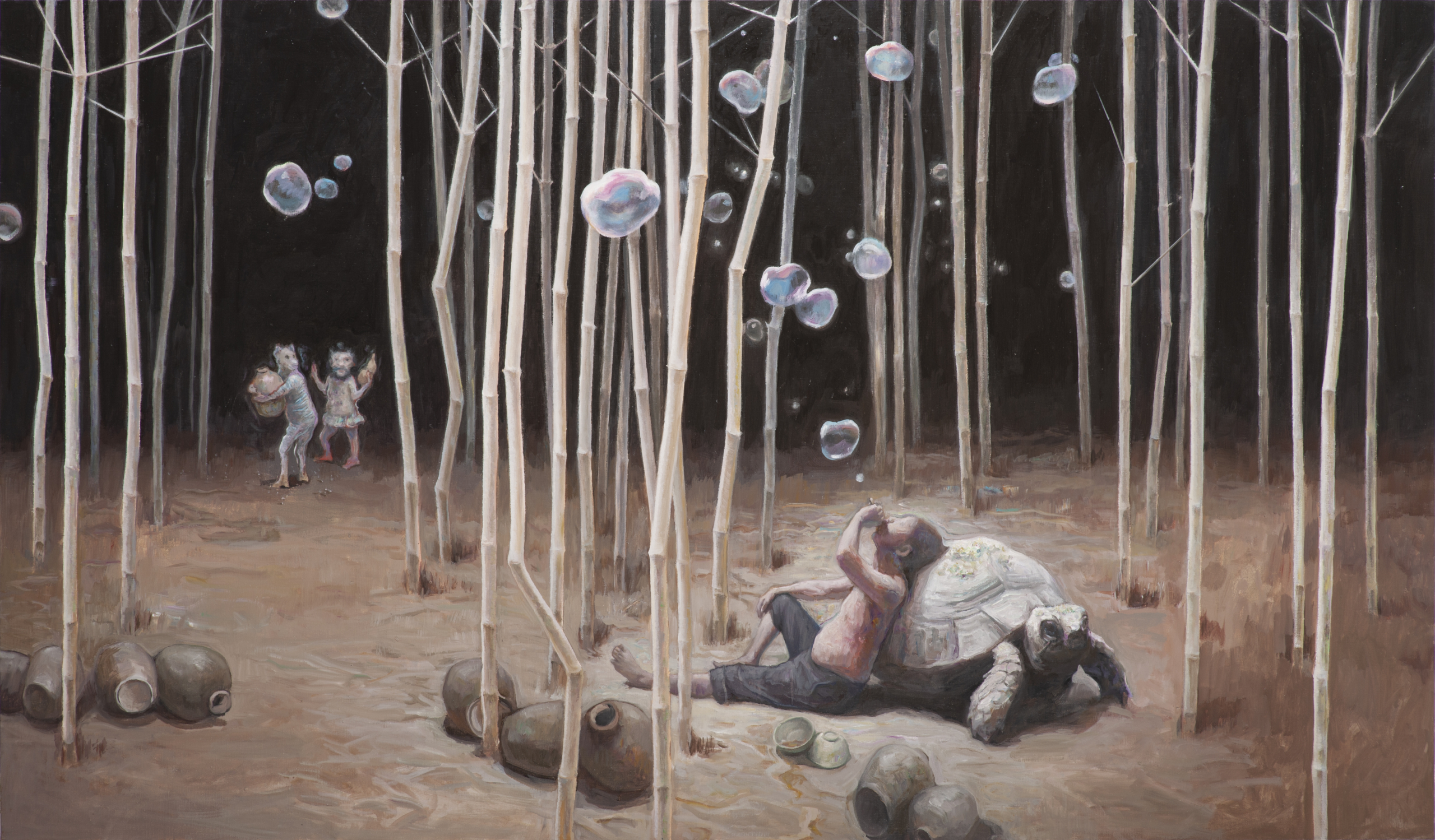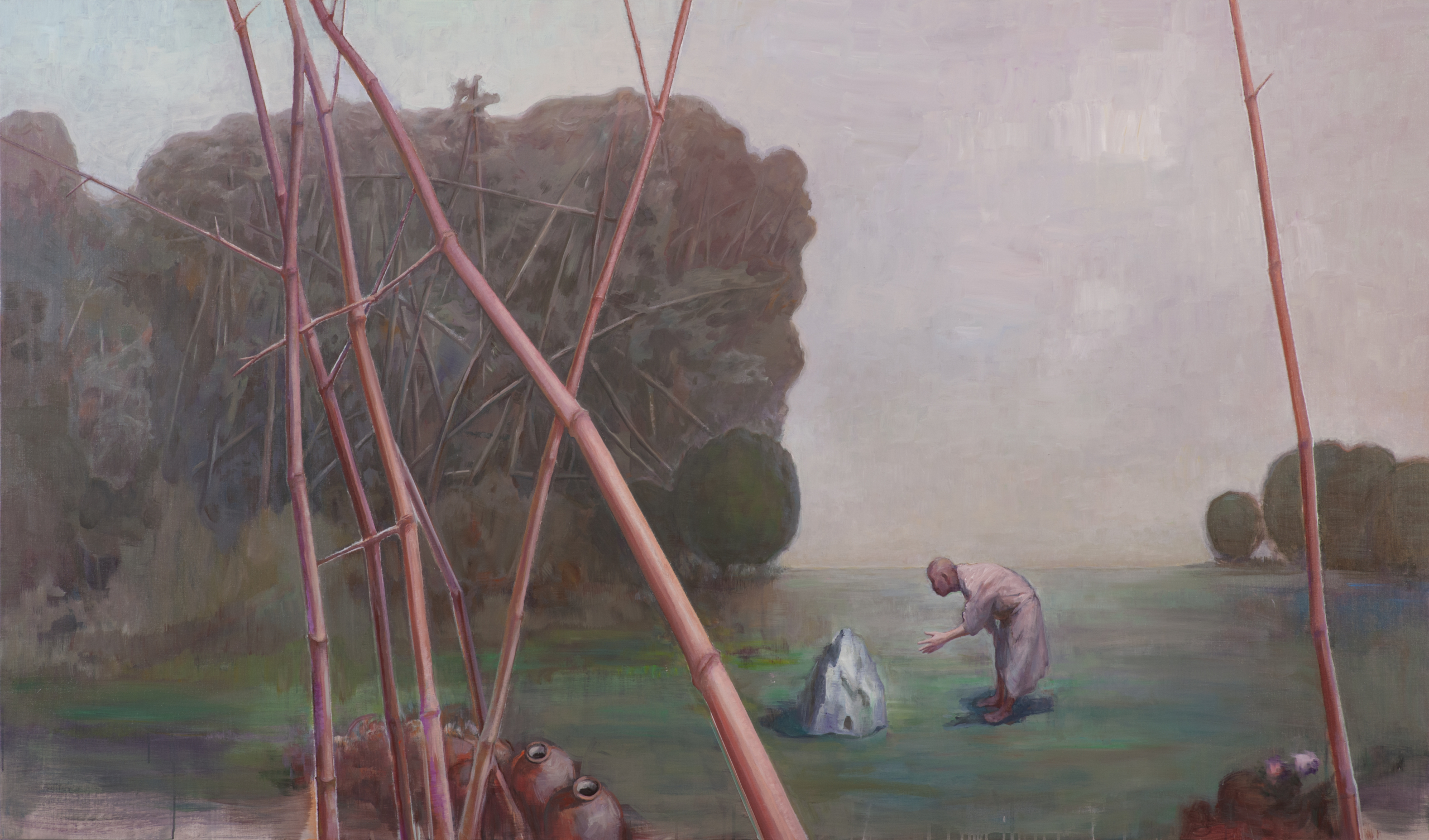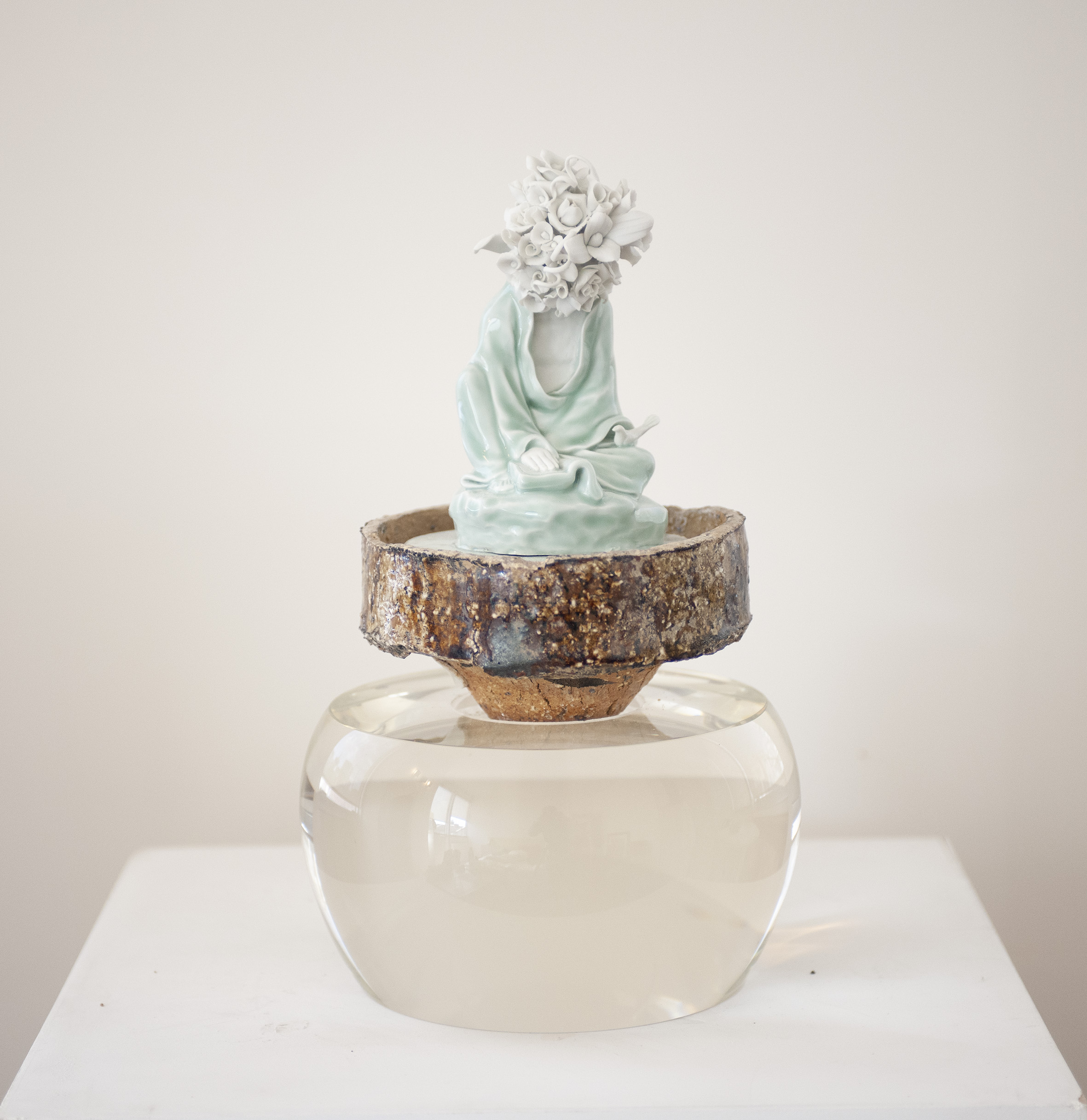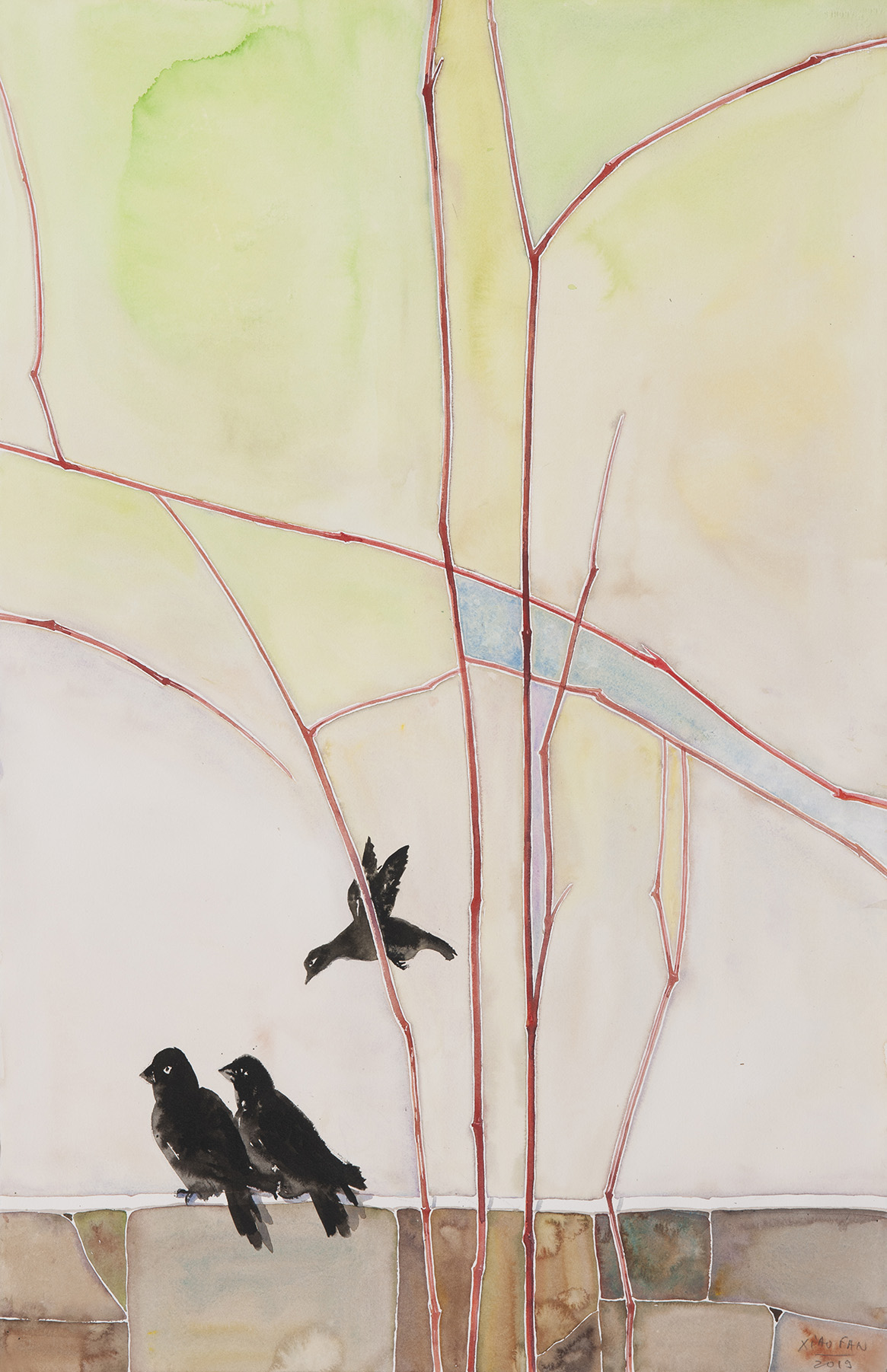RU XIAOFAN
Allemonde
RU XIAOFAN Solo Exhibition (Oil on canvas, sculpture and drawing)
22 September – 15 November 2022

RU XIAOFAN, Ivresse n° 3, 2021, oil on canvas, 114 x 195 cm

RU XIAOFAN, Ivresse n° 2, 2021, oil on canvas, 114 x 195 cm

RU XIAOFAN, Ivresse n° 1, 2021, oil on canvas, 114 x 195 cm

RU XIAOFAN, Ivresse n° 4, 2022, oil on canvas, 114 x 195 cm

RU XIAOFAN, Lecture, 2019, sculpture (6/8)

RU XIAOFAN, boire seul, 2019, sculpture (6/8)

RU XIAOFAN, bouteille propre, 2019, sculpture (6/8)

RU XIAOFAN, Sain enfant, 2018, watercolour on paper, 36 x 27 cm

RU XIAOFAN, Bambou rouge n°9, 2019, aquarelle sur papier, 102 x 66 cm.
ALLEMONDE
Solo exhibition of RU XIAOFAN
22 September 2022 – 15 November 2022
„I will never be able to leave this forest“ (Scene 1 of Act 1 of Claude Debussy’s opera „Pélleas et Mélisande“), sings Golaud, who, as grandson of the old king Arkel, has lost his way in the depths of the forest during a hunting trip. And yet, from the forest to the kingdom of Allemonde, the musical journey will be an enchantment, a lyrical experience, innovative and unmissable. Debussy wanted music for the inexpressible: „It must come out of the shadows. It must be discreet“. If we put aside Pélléas et Mélisande, which has become a musical monument, and keep more serenely the journey to the kingdom of „Allemonde“, this imaginary kingdom is like a perfect mirror to present today a part of the whole work of art of the painter and ceramist RU XIAOFAN. A composer and a painter is a surprising association of two interventions (an opera and a serie of paintings) but which actually take us to the middle of the forest to follow them in their aesthetic research so positive to think and describe the world and perhaps understand unique and remarkable poetic impressions.
RU XIAOFAN was born into a family of scholars and was nicknamed by one critic the „Chinese Proustian painter“. During his childhood he learned calligraphy. He graduated from the school of fine arts in Nanjing and then from the Ecole Normale Supérieure des Beaux-Arts in Paris. He studied in the studio of Olivier Debré and Pierre Alechinsky. He was a guest artist at the Casa Velasquez in Madrid in 1988 and 1990. RU XIAOFAN follows in the footsteps of the great artists who travelled from China to France and trained in Paris, such as Chu Teh-chun and Zao Wou-ki among others. RU XIAOFAN is in France but he will also visit Spain and will be marked by great places, great works: churches, the Battle of San Romano by Paolo Uccello whose bamboo spears he will transform in many works. RU XIAOFAN offers an original and remarkable work of art in progress. RU XIAOFAN became known to the public with the creation of his important series of One Hundred Flowers (1999-2002). The theme ironically refers to Mao Zedong’s slogan „Let a hundred flowers bloom, let a hundred schools compete“, which launched the campaign of the same name and preceded the first repressions against intellectual and artistic circles. RU XIAOFAN’s Flowers are hybrid beings, often adorned with exaggerated feminine attributes. Since that time, the floral theme has been central to RU XIAOFAN’s creations. RU XIAOFAN constantly innovates with several artistic materials (crystal, lacquer, metal, or ceramics) to highlight his artistic research.
ALLEMONDE
Solo Austellung mit dem Künstler RU XIAOFAN
22 septembre 2022 – 15 novembre 2022
„Ich kann nicht mehr aus diesem Wald herauskommen“ (1. Szene des 1. Aktes der Oper „Pélleas et Mélisande“ von Claude Debussy), singt Golaud, der Enkel des alten Königs Arkel, der sich während eines Jagdausflugs in den Tiefen des Waldes verirrt hat:. Und doch wird die musikalische Reise vom Wald bis zum Königreich Allemonde ein Zauber, ein lyrisches Erlebnis, innovativ und unverzichtbar sein. Debussy wollte eine Musik für das Unaussprechliche: „Sie muss aus dem Schatten treten. Sie muss diskret sein. Wenn wir Pélléas et Mélisande, das zu einem musikalischen Monument geworden ist, beiseite lassen und stattdessen die Reise ins Königreich „Allemonde“ fortsetzen, ist dieses imaginäre Königreich wie ein perfekter Spiegel, um heute einen Teil des Gesamtkunstwerks des Malers und Keramikers RU XIAOFAN zu präsentieren. Ein Komponist und Maler ist eine überraschende Verbindung von zwei Interventionen (eine Oper und eine Reihe von Gemälden), die uns aber tatsächlich in die Mitte des Waldes führen, um ihnen in ihrer ästhetischen Forschung zu folgen, die so positiv ist, die Welt zu denken und zu beschreiben und vielleicht einzigartige und bemerkenswerte poetische Eindrücke zu verstehen.
RU XIAOFAN wurde in eine Gelehrtenfamilie geboren und von einer Kritikerin als „chinesischer Proust-Maler“ bezeichnet. In seiner Kindheit lernte er die Kalligraphie. Er absolvierte die Kunstakademiein Nanjing und anschließend die Kunstakademie in Paris. Er studierte in den Ateliers von Olivier Debré und Pierre Alechinsky. In den Jahren 1988 und 1990 war er Gastkünstler in der Casa Velasquez in Madrid. RU XIAOFAN steht in der Tradition der großen Künstler, die von China nach Frankreich reisten und in Paris studierten, wie Chu Teh-chun, Zao Wou-ki und andere. RU XIAOFAN ist in Frankreich, besucht aber auch Spanien und wird von großen Orten und großen Werken geprägt: Kirchen, die Schlacht von San Romano von Paolo Uccello, dessen Bambuslanzen er in zahlreichen Werken verarbeitet. RU XIAOFAN bietet mit seinem gesamten aktuellen Kunstwerk ein originelles und bemerkenswertes Werk. RU XIAOFAN wurde der Öffentlichkeit durch die Realisierung seiner bedeutenden Serie Hundert Blumen (1999-2002) bekannt. Das Thema bezieht sich auf ironische Weise auf Mao Zedongs Losung „Lasst hundert Blumen blühen, lasst hundert Schulen wetteifern“, die die gleichnamige Kampagne einleitete und den ersten Repressionen, die sich gegen intellektuelle und künstlerische Kreise richteten, voranging. RU XIAOFANs Blumen sind Mischwesen, die oft mit übersteigerten weiblichen Attributen ausgestattet sind. Seit dieser Zeit nimmt das Blumenthema einen zentralen Platz in RU XIAOFANs Schöpfungen ein. RU XIAOFAN innoviert ständig mit verschiedenen künstlerischen Materialien (Kristall, Lack, Metall oder Keramik), um seine künstlerische Forschung in den Vordergrund zu stellen.
ALLEMONDE
Exposition solo de l’artiste RU XIAOFAN
22 septembre 2022 – 15 novembre 2022
“Je ne pourrai plus sortir de cette forêt” (Scène 1 de l’acte 1 de l’opéra “Pélleas et Mélisande” de Claude Debussy ), chante Golaud, qui petit-fils du vieux roi Arkel, s’est perdu dans les profondeurs de la forêt lors d’une partie de chasse chante:. Et pourtant, de la forêt au royaume d’Allemonde, le parcours musical sera un enchantement, une expérience lyrique, innovante et incontournable. Debussy voulait une musique pour l’inexprimable: “Elle doit sortir de l’ombre. Être discrète”. Si on met de côté Pélléas et Mélisande qui est devenu un monument musical et gardons plus sereinement le voyage au royaume d’“Allemonde”, ce royaume imaginaire est comme un parfait miroir pour présenter aujourd’hui une partie de l’ensemble de l’oeuvre d’art de l’artiste peintre et céramiste RU XIAOFAN. Un compositeur et un peintre est une association surprenante de deux interventions (un opéra et une série de tableaux ) mais qui nous emmènent en fait en pleine forêt pour les suivre dans leur recherche esthétique si positive à penser et décrire le monde et peut-être comprendre des impressions poétiques uniques et remarquables.
RU XIAOFAN est né dans une famille de lettrés et et surnommé par une critique le “peintre proustien chinois”. Pendant son enfance il apprend la calligraphie. Il est diplômé de l’Ecole normale supérieure des Beaux-Arts de Nankin puis de celle de Paris. Il étudie dans l’atelier d’Olivier Debré et de Pierre Alechinsky. Il fut artiste invité de la Casa Velasquez à Madrid en 1988 et 1990. RU XIAOFAN s’inscrit dans la lignée des grands artiste qui firent le voyage de la Chine en France et vinrent se former à Paris tels que Chu Teh-chun et Zao Wou-ki entre autres. RU XIAOFAN est en France mais il visitera aussi l’Espagne et sera marqué par des grands lieux, de grandes oeuvres: les églises, the Battle of San Romano de Paolo Uccello dont il transformera les lances en bambou dans de nombreuses oeuvres. RU XIAOFAN offre à travers l’ensemble de son oeuvre d’art en cours un travail original et remarquable. RU XIAOFAN s’est fait connaître du public par la réalisation de son importante série des Cent fleurs (1999-2002). Le thème renvoie de manière ironique au mot d’ordre de Mao Zedong « Que cent fleurs s’épanouissent, que cent écoles rivalisent », qui avait lancé la campagne du même nom, et précédé les premières répressions dirigées contre les milieux intellectuels et artistiques. Les Fleurs de RU XIAOFAN sont des êtres hybrides, souvent parés d’attributs féminins exacerbés. Depuis cette époque, le thème floral occupe une place centrale dans les créations de RU XIAOFAN. RU XIAOFAN innove sans cesse avec plusieurs matériaux artistiques (cristal, laque, métal, ou céramique) pour mettre en avant sa recherche artistique.
